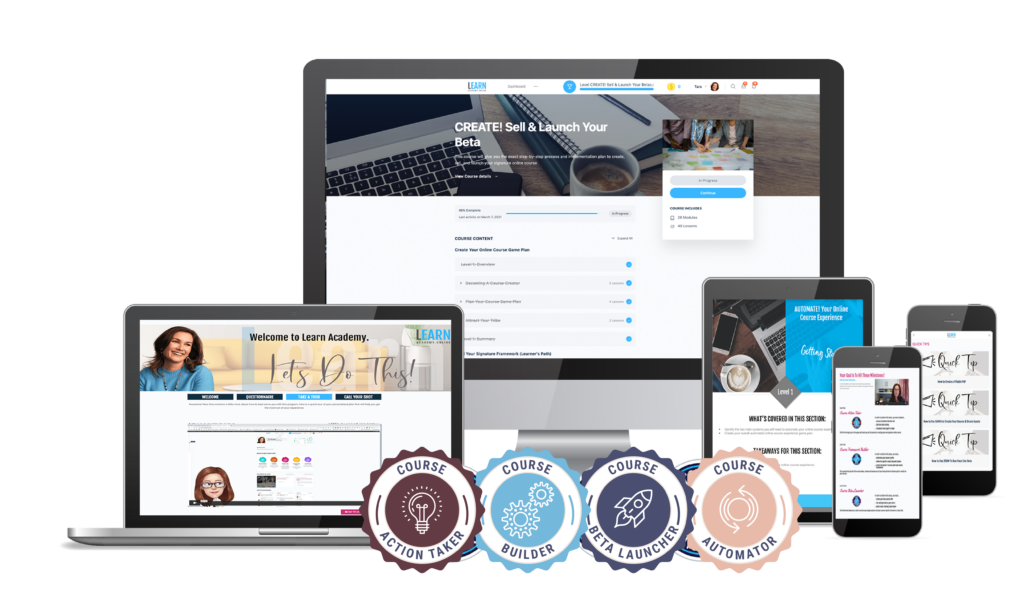In the world of business and product development, there’s a paradox that often holds people back: the desire for perfection before launch.
We convince ourselves that our offering needs to be flawless, comprehensive, and polished before we can share it with the world. But what if I told you that this mindset is not only unnecessary but potentially harmful to your success?
The beta experience—a preliminary version of your product, service, or program launched to a small audience for testing and feedback—might be the most valuable phase of your creation process.
It’s in this space of imperfection and iteration that true innovation happens.
In this post, we’ll explore why creating and launching a beta experience is crucial for entrepreneurs, course creators, coaches, and anyone bringing a new idea to market.
We’ll dive into the psychological barriers that keep us from taking action, the strategic advantages of beta launches, and practical steps to create a beta experience that serves both you and your early adopters.
The Perfection Paralysis
Have you ever found yourself saying:
“I’ll launch when my course has all the modules completed.”
“I need to refine my methodology before I share it.”
“I can’t put this out until I have professional videos.”
“I need more case studies before I can claim expertise.”
This is perfection paralysis—the belief that everything must be complete and flawless before you can take action. It’s a form of procrastination masked as quality control, and it’s one of the biggest obstacles to bringing your ideas to life.
The truth is, perfection is an illusion. Even the most successful products and services we use today began as rough prototypes. The first iPhone lacked copy and paste functionality. Early versions of Facebook were limited to college students and had a fraction of the features it has now. Amazon started as just an online bookstore.
These now-iconic products evolved through feedback, iteration, and a willingness to start somewhere, even if that somewhere was imperfect.
The Strategic Advantages of a Beta Experience
1. Real-World Validation
The most significant benefit of a beta experience is that it provides real-world validation for your idea. You can spend months or even years developing something in isolation, only to discover that it doesn’t solve a problem people actually have or are willing to pay for.
A beta experience allows you to test your assumptions in the market.
- Does your solution resonate with your target audience?
- Are people willing to pay for it?
- What features do they find most valuable?
These questions can only be answered by putting your offering in front of real users.
2. Feedback-Driven Refinement
When you launch a beta experience, you’re essentially inviting your early adopters to become co-creators. Their feedback becomes the compass that guides your development process.
This feedback is invaluable because it comes from people who are actually using your product or service in their real lives.
They’ll identify pain points you never considered, suggest features you hadn’t thought of, and help you understand how your offering fits into their workflow or lifestyle.
3. Community Building
A beta experience creates a unique opportunity to build a community around your offering. Early adopters often become your most loyal advocates if they feel their input is valued and incorporated into the evolution of your product.
These initial users develop a sense of ownership in your success. They’ve been part of the journey from the beginning, and they want to see you succeed. This community can become a powerful force in spreading the word about your offering when you’re ready for a full launch.
4. Risk Mitigation
Launching a beta experience minimizes financial and reputational risk. Rather than investing all your resources into a fully developed product that might miss the mark, you can allocate a smaller budget to test your concept.
If the beta experience reveals that significant changes are needed, you can pivot before committing more resources. If the concept proves successful, you can invest in scaling with confidence.
5. Accelerated Learning
The compressed timeline of a beta launch forces you to focus on the essential elements of your offering.
This constraint can actually drive creativity and innovation as you determine what features are truly necessary for your minimum viable product (MVP).
The learning curve is steep during a beta experience phase, but the insights gained are proportionally valuable.
You’ll learn more about your market, your users, and your own capabilities in a few weeks of beta testing than you might in months of isolated development.
Psychological Barriers to Taking Imperfect Action
Understanding the advantages of beta experience launches is one thing, but overcoming the psychological barriers to taking imperfect action is another challenge entirely.
Let’s explore some common obstacles and how to overcome them:
Fear of Judgment
At the core of perfection paralysis is often a fear of being judged. We worry that if our offering isn’t flawless, people will criticize us, question our expertise, or dismiss our ideas.
Overcoming it: Remember that constructive criticism is a gift, not a threat. It’s feedback that helps you improve. Also, most people are far more focused on what your offering can do for them than on scrutinizing its imperfections.
Impostor Syndrome
Many creators struggle with feeling like they’re not qualified enough to offer their product or service. They delay launching because they’re waiting to feel “ready” or “expert enough.”
Overcoming it: Recognize that expertise is relative. You don’t need to know everything—you just need to know more than your target audience about your specific topic. Also, remember that your unique perspective and experience are valuable in themselves.
Comparison Trap
In the age of social media, it’s easy to compare your beginning to someone else’s middle or end. You see polished final products from established competitors and feel your beta version doesn’t measure up.
Overcoming it: Remind yourself that every successful product or service started somewhere. Focus on your own journey and the value you’re providing to your early adopters, not on how your offering compares to others that may have been in development for years.
Attachment to the Vision
Sometimes, we become so attached to our perfect vision of what our offering should be that we’re reluctant to release anything that falls short of that ideal.
Overcoming it: Embrace the idea that your initial vision is just a starting point. The final product may look quite different based on real-world feedback, and that’s not only okay—it’s preferable. Your goal should be to create something that serves your users, not to perfectly manifest your original concept.
Creating Your Beta Experience:
Now that we understand the strategic advantages of beta experience launches and the psychological barriers to overcome, let’s explore how to create and launch a beta experience effectively.
1. Define Your Minimum Viable Product (MVP)
The first step is to identify the core features or components that make up your minimum viable product.
Ask yourself:
- What problem does my offering solve?
- What are the essential features needed to solve this problem?
- What can be added later after I’ve gathered feedback?
Be ruthless in distinguishing between “must-have” and “nice-to-have” features. It means focusing on the core functionality without all the bells and whistles.
2. Set Clear Expectations
Transparency is key when launching a beta experience. Clearly communicate to your early adopters what they can expect:
- What features are included in the beta version?
- What features are planned for future releases?
- How long will the beta period last?
- How can participants provide feedback?
- What benefits do they receive for being early adopters?
Setting clear expectations prevents disappointment and helps your beta testers focus their feedback on the aspects that matter most at this stage.
3. Create a Feedback System
Establish a structured way for beta experience testers to share their experiences and suggestions.
This might include:
- Regular surveys or questionnaires
- One-on-one interviews or feedback sessions
- A dedicated community forum or Slack channel
- Direct email communication
- Use a tool like Markup.io to get inline comments
Make providing feedback as easy as possible, and show genuine appreciation for every piece of input you receive.
4. Embrace Iteration
The beta experience phase is all about iteration. Be prepared to make changes quickly based on feedback.
This might mean:
- Adjusting features that aren’t working as expected
- Adding small enhancements that create significant value
- Removing elements that cause confusion or don’t add value
- Refining your messaging based on how users describe their experience
Each iteration brings you closer to a product that truly resonates with your target audience.
5. Celebrate Progress
Don’t wait until the end of the beta experience period to celebrate successes.
Acknowledge milestones along the way:
- The first piece of user feedback implemented
- The first problem solved for a customer
- The first testimonial received
- The first iteration completed
Celebrating these small wins keeps your motivation high and reinforces the value of the beta process.
Embracing the Iterative Journey
Creating and launching a beta experience is not just a strategic business decision—it’s a mindset shift.
It’s about embracing the iterative nature of creation and recognizing that your first version doesn’t need to be your final version.
This mindset extends beyond product development. It applies to your marketing, your customer service, your business model, and even your personal growth as an entrepreneur.
When you embrace imperfect action as a philosophy, you free yourself from the paralysis of perfection and open yourself to continuous improvement.
Remember:
Perfect is the enemy of done.
Feedback is a gift that shapes your offering.
Your early adopters are not just customers; they’re co-creators.
Every successful product or service started as someone’s imperfect action.
Taking Your First Step
If you’re standing at the edge of action, hesitating because your offering isn’t perfect yet, ask yourself: What’s the smallest step I can take today to move forward?
Perhaps it’s writing an outline for your beta program, creating a landing page to gauge interest, or reaching out to potential beta testers in your network.
Whatever it is, take that step today.
The journey of a thousand miles begins with a single step, and the journey to a successful offering begins with imperfect action.
Your beta experience isn’t just a preliminary version of your product—it’s the foundation upon which you’ll build something truly remarkable.
So, let go of the need for perfection. Embrace the power of the beta experience. And take that imperfect action today. Your future self—and your future customers—will thank you for it.
Conclusion
In a world that often celebrates perfection, there’s profound power in embracing imperfection as part of the creative process.
A beta experience isn’t just a testing phase; it’s a strategic approach to product development that values real-world feedback over theoretical perfection.
By launching before you feel ready, you gain invaluable insights, build a community of early supporters, and create something that truly resonates with your target audience. You also free yourself from the paralysis of perfection and experience the joy of seeing your creation in the hands of the people it was designed to serve.
Remember, the most successful products and services we use today didn’t start as perfect offerings. They started as someone’s imperfect action, refined through feedback and iteration. Your beta experience is not just a stepping stone to your final product—it’s the crucial first step in a journey of continuous improvement and innovation.
So, what imperfect action will you take today?
If you want help with your beta experience, be sure to schedule a call to discuss your options.







